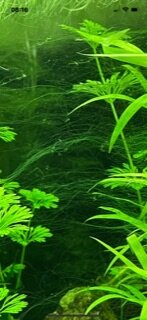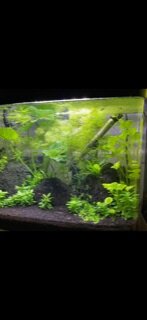SteveMid
Member
I have plucked up courage to post a thread about algae. Hopefully I won’t regret it 😂.
A few months ago I set up a 40litre low tech planted tank primarily to house/breed shrimp. I bought some attractive looking bog wood from a local reputable aquarium shop as part of the hard scape. Whilst there I bought another piece to add to my main 240litre well-established planted tank (a higher tech set up with CO2 injection). The first picture is the newly planted 40L tank after about 3 weeks of cycling.

When I was happy parameters were ok I added some shrimp and all seemed well. Then I got a big outbreak of hair algae - ok so it was a new set up - so these things happen right?…but I also got a simultaneous outbreak in my established 240L tank (2 years old). Which I had placed the other piece of wood. See picture 2 of hair algae outbreak.

I started to lose a couple of shrimps in the new tank and started to pick up small amounts of nitrite when I tested and even with daily water changes it was still there. In the end I removed the wood from both tanks. Carried out big water changes and even had to do a 4 day blackout on my main 240L tank.
Eventually all settled down and the hair algae eventually disappeared from both tanks. See last picture which is the shrimp tank now. All is fine and I have a perfectly healthy breeding population of shrimp. No algae at all.

I took one of the pieces of wood and put in freshly conditioned tap water over night and picked up ammonia in the test the next day (I think it was ~0.5ppm. I double checked the tap water had 0ppm ammonia in it. I concluded the wood must have been leaching out something that caused this unless it was a huge coincidence.
Has anyone else experienced this phenomena in their tanks. Other than tannins, I thought bog wood was relatively inert/harmless. Was it a dodgy batch of wood? 🤷🏼♂️
I’d love to have some bogwood in one of my tanks but I feel I have had my fingers burnt. Should I have prepared it differently prior to adding to tank? I hoping some of the knowledge on this forum will help me understand. Thanks
A few months ago I set up a 40litre low tech planted tank primarily to house/breed shrimp. I bought some attractive looking bog wood from a local reputable aquarium shop as part of the hard scape. Whilst there I bought another piece to add to my main 240litre well-established planted tank (a higher tech set up with CO2 injection). The first picture is the newly planted 40L tank after about 3 weeks of cycling.

When I was happy parameters were ok I added some shrimp and all seemed well. Then I got a big outbreak of hair algae - ok so it was a new set up - so these things happen right?…but I also got a simultaneous outbreak in my established 240L tank (2 years old). Which I had placed the other piece of wood. See picture 2 of hair algae outbreak.

I started to lose a couple of shrimps in the new tank and started to pick up small amounts of nitrite when I tested and even with daily water changes it was still there. In the end I removed the wood from both tanks. Carried out big water changes and even had to do a 4 day blackout on my main 240L tank.
Eventually all settled down and the hair algae eventually disappeared from both tanks. See last picture which is the shrimp tank now. All is fine and I have a perfectly healthy breeding population of shrimp. No algae at all.

I took one of the pieces of wood and put in freshly conditioned tap water over night and picked up ammonia in the test the next day (I think it was ~0.5ppm. I double checked the tap water had 0ppm ammonia in it. I concluded the wood must have been leaching out something that caused this unless it was a huge coincidence.
Has anyone else experienced this phenomena in their tanks. Other than tannins, I thought bog wood was relatively inert/harmless. Was it a dodgy batch of wood? 🤷🏼♂️
I’d love to have some bogwood in one of my tanks but I feel I have had my fingers burnt. Should I have prepared it differently prior to adding to tank? I hoping some of the knowledge on this forum will help me understand. Thanks




